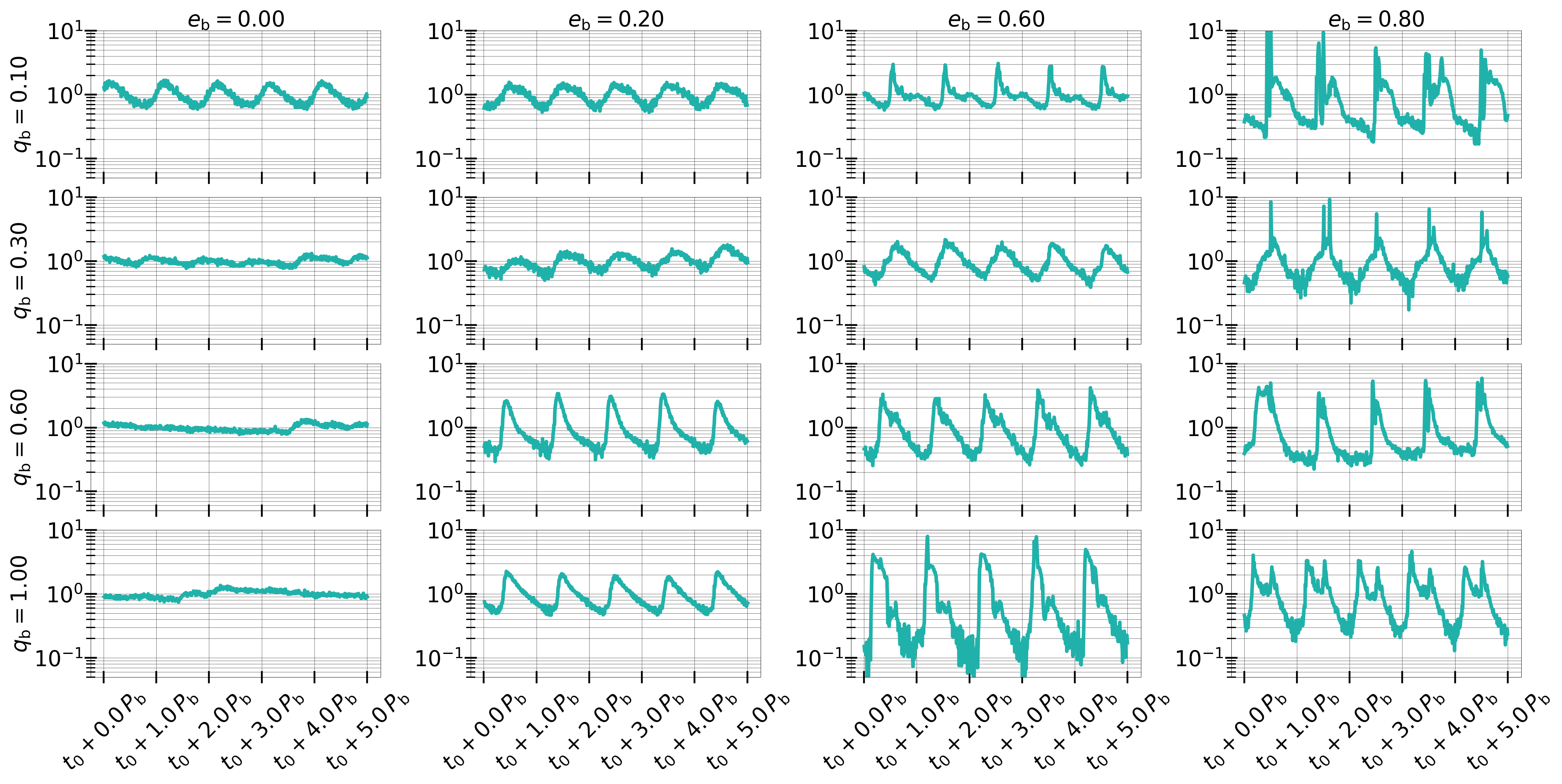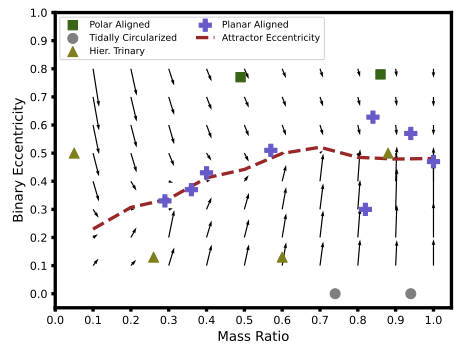About Me
About Me
I'm Magdalena Siwek, a theoretical astrophysicist working on black hole phenomena.
In May 2024, I earned my PhD from Harvard University. Since September 2024, I've been a Junior Fellow with the Simons Society of Fellows, first at Columbia University and now at New York University. I develop hydrodynamic simulations of accretion disks around binary systems using the moving mesh code Arepo. My simulations shed light on the fate of the most massive black hole binaries (MBHBs): Do they merge, or do they stall? What is the effect of gas on their orbital properties, and on the multi-messenger signals they emit? As a full member of the NANOGrav collaboration, I utilize results from my binary simulations to inform the evolution of nano-Hertz gravitational wave sources by co-developing the MBHB population synthesis code holodeck.
I am originally from Germany, but completed my undergraduate (BSc) and graduate (MSci) studies in physics and astronomy at the University of Glasgow, before starting my PhD at Harvard University in 2018. While at Harvard, I founded and ran the CfA's very own community garden. I am also an avid mushroom hunter.
- Name:Magdalena Siwek
- Research Interests:Multi-Messenger Astrophysics, Massive Black Hole Binaries, Hydrodynamics
- Current Position:Junior Fellow with the Simons Society of Fellows at New York University.
- PhD Advisor:Lars Hernquist
- Education:
2024 - PhD in Astrophysics, Harvard University
2018 - MSci, University of Glasgow
2017 - BSc, University of Glasgow
Research
Research
Circumbinary Disk Hydrodynamics
Accretion disks around binary systems (also known as circumbinary disks; CBDs) can range in scale from protoplanetary disks around stellar binaries, up to accretion disks around massive black hole binaries (MBHBs) at the centres of galaxies.
I recently published the largest hydrodynamic parameter study of binaries and accretion disks to date, and use data from this simulation suite to study the orbital evolution of binary systems in CBD systems.
Low-frequency Gravitational Waves (PTAs)
Pulsar Timing Arrays (PTAs) have now found compelling evidence for the existence of a Gravitational Wave Background (GWB): a ‘hum’ of low-frequency gravitational waves that permeates the Universe. In my thesis work I found that CBD accretion can significantly boost the gravitational wave background. I model the MBHB populations that produce the low-frequency GWB detected with PTAs, and quantify the effect of gas dynamics on the GWB spectrum.

Multimessenger Astrophysics
Circumbinary Disks are associated with periodic accretion variability in the binary system they host. In binary AGN, this will likely be visible as periodic luminosity variability with upcoming telescopes. Combining machine learning and large hydrodynamic simulations, I develop tools to detect and characterize the electromagnetic observations of MBHB populations.

Stellar Mass Binaries
Circumbinary Disks form on all scales, from protoplanetary disks to AGN disks. During the formation of binary stars, the formation of a circumbinary disk may occur. In Siwek+2023b, we found that CBDs drive binary systems to equilibrium eccentricities, which are proportional to the mass ratio of the binary. Evidence for this effect was recently been found in actively accreting stellar binaries! Shown above in Figure 2 from Murray & Duffell (2025).
LIGO progenitors
At the end of their lives, some stellar binaries are believed to undergo common envelope evolution before merging and emitting GWs detected by LIGO. Some models suggest that the envelope is not entirely ejected and may fall back onto the binary. I am interested the subsequent orbital evolution of such systems, investigating whether the fallback can form a circumbinary disk. If so, LIGO sources may have undergone orbital evolution processes similar to those I have investigated in my hydrodynamic simulations.
Magnetic fields in Circumbinary Disks
Most circumbinary disk simulations neglect the presence of magnetic fields, approximating the angular momentum transport with an alpha model. However, whether the alpha model is appropriate in the complex morphology of the CBD is highly uncertain. I am currently expanding my simulations to include self-consistent viscosity modeling by resolving the Magnetorotational Instability (MRI). I will investigate whether this changes the accretion behaviour of the binary and its orbital evolution, and look for electromagnetic transient signals that cannot be modeled with pure hydrodynamics.
Publications
Publications
October 2024
Signatures of Circumbinary Disk Dynamics in Multi-Messenger Population Studies of Massive Black Hole Binaries
Magdalena Siwek, Luke Zoltan Kelley, Lars Hernquist
In this work, we combine the CBD models from my suite of hydrodynamic simulations and apply it to a MBHB population synthesis model based on galaxy merger rates from the cosmological simulation Illustris. We find that MBHB populations detected in PTAs, LSST and even LISA show a significant (1-2 orders of magnitude) increase in their eccentricity distributions when CBD models are applied. Our results suggest that detections of eccentric MBHBs are the rule rather than the exception in upcoming transient surveys, provided that CBDs regularly form in MBHB systems. This is due to the eccentricity pumping effects found in my simulations. We also find that eccentric harmonics are much more likely to be detected in LISA with the influence of CBD accretion.
June 2023
Orbital Evolution of Binaries in Circumbinary Disks
Magdalena Siwek, Rainer Weinberger, Lars Hernquist
Binaries on many scales encounter circumbinary disk (CBD) driven evolution at some point in their lives. But how does the presence of a CBD affect the orbital elements of the binary? In this work, we ran the largest to-date parameter study over binary mass ratio (q) and eccentricity (e), evaluating how the interaction with the CBD is affected by varying the parameters q and e. We discovered that mass ratio and eccentricity become correlated very quickly in the presence of a CBD, that is, the eccentricity evolves to an equilibrium value that is determined by the mass ratio of the system. I am excited to see whether we can find evidence of this dynamical effect in massive black hole or stellar binary populations.
Feb 2023
Preferential accretion and circumbinary disk precession in eccentric binary systems
Magdalena Siwek, Rainer Weinberger, Diego Muñoz, Lars Hernquist
Accretion from circumbinary disks (CBDs) has been known to increase the mass ratio of the binary system, by preferentially accreting onto the secondary (lower mass) component. But this statement has only been proven in special cases: binaries on circular orbits. In this work, we scanned the parameter space of eccentric, unequal mass ratio binary systems and investigated their accretion behaviour. We find that when compared with circular binaries, mass ratios grow more efficiently in binaries on moderately eccentric orbits while high eccentricities suppress mass ratio growth. We further identify three regimes of CBD evolution: free and forced precession, and disk 'locking'.
Oct 2020
The effect of differential accretion on the gravitational wave background and the present-day MBH binary populations
Magdalena Siwek, Luke Zoltan Kelley, Lars Hernquist
Pulsar Timing Arrays (PTAs) have now found compelling evidence for the existence of a Gravitational Wave Background (GWB). However, their evolution histories, including accretion phases, are still uncertain. Here, we investigate the influence of circumbinary disk accretion on MBHB merger rates, chirp masses, and the resulting GWB spectrum. We find that CBD accretion can increase the median mass ratio of coalescing MBHBs by up to a factor 3.6, the coalescence rate by 52.3 per cent, and the GWB amplitude by a factor 4.0. We further predict binary separation and mass ratio distributions of stalled MBHBs in the low-redshift Universe, and find that these depend sensitively on binary accretion models. This presents the potential for combined electromagnetic and GW observational constraints on merger rates and accretion models of MBHB populations.
Teaching
Teaching

ASTRON17: Galactic and Extragalactic Astronomy Teaching Fellow, Harvard University
In 2020 and 2021 I served as a teaching fellow for ASTRON17, taught by Daniel Eisenstein. Due to the COVID-19 pandemic, the class had to be restructured to work in a fully remote setting. I helped with the redesign of the class and subsequently taught it in both 2020 and 2021, holding sections and office hours. In both years, I received the Derek Bok Center Certificate of Distinction in Teaching from Harvard University.

Skype A Scientist Outreach Volunteer
Since 2019, I have been volunteering with Skype A Scientist. As a volunteer, I regularly connect with classrooms all over the world to teach them about my research and answer general science questions. It has taught me a lot about nurturing curiosity from an early age!